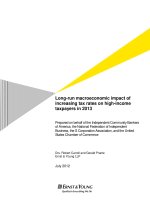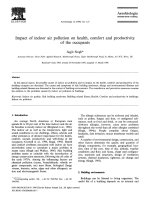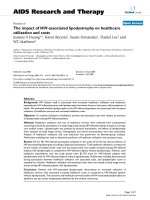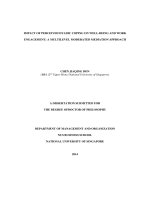IMPACT OF PERCEIVED DYADIC COPING ON WELL BEING AND WORK ENGAGEMENT a MULTILEVEL MODERATED MEDIATION APPROACH
Bạn đang xem bản rút gọn của tài liệu. Xem và tải ngay bản đầy đủ của tài liệu tại đây (978.16 KB, 225 trang )
IMPACT OF PERCEIVED DYADIC COPING ON WELL-BEING AND WORK
ENGAGEMENT: A MULTILEVEL MODERATED MEDIATION APPROACH
CHEN JIAQING DON
(BBA (2
nd
Upper Hons) National University of Singapore)
A DISSERTATION SUBMITTED FOR
THE DEGREE OFDOCTOR OF PHILOSOPHY
DEPARTMENT OF MANAGEMENT AND ORGANIZATION
NUS BUSINESS SCHOOL
NATIONAL UNIVERSITY OF SINGAPORE
2014
DEDICATIONS
To my wife and son,
Yve Yuan
and
Cayden Chen
ACKNOWLEDGEMENTS
This dissertation won’t have been possible if not for the support and guidance that I have
received. I owe my deepest gratitude to everyone who has helped made this doctoral journey
possible, and a little more palatable.
I wish to thank my supervisor and co-supervisor, A/P Song Zhaoli and A/P Vivien Lim and my
committee member, Professor Remus Ilies, for providing guidance and feedback throughout the
dissertation process.
Professor Richard Arvey, I am glad to have the opportunity to work with you on the book
chapter. Thank you for keeping a look out for me and for penning my referral letter. Dr Sandy
Lim and Dr William Koh, it has been my pleasure to have tutored for your classes. Dr Krishna
Savani, thank you for having me as your TA and for the many professional advices that you had
given me. I have benefited tremendously from observing your classes. Dr Jayanth Narayanan,
really appreciate the advices that you have given to me. They have helped me stay focus on my
goals. To the rest of the faculty members, thank you for the friendships, advices, and patience.
This doctoral journey would have been a lonely one if not for my dependable friends, colleagues,
and office mates. Xiangyu, Wendong, and Kenneth are the best cohort mates that I could ever
wish for. The discussions, brainstorming sessions, and debates we had over theories and methods
have certainly helped enriched my professional development. Yan Zheng, my occasional lunch
buddy, thank you for listening to my grouses when things got rough, and of course for being the
Mandarin emcee at my wedding. Wang Nan, I won’t have been able to complete this dissertation
without your mentorship on STATA. Lin Jia, my gratitude for the various discussions we had on
MSEM and for your generosity in sharing with me what you know about MSEM. To the rest of
my M&O PhD colleagues, 加油!
I also wish to thank the colleagues from the PhD office and the department office for their
support and assistance. Cheow Loo, thank you for resolving the various administrative
nightmares that I have caused and for your kind assistance throughout the last 6 years. Wendy,
Sally, Latifah and Jenny, thank you for the administrative assistance that all you have rendered. I
won’t have been able to recruit subject pool participants, book seminar rooms and labs, collect
data, and process my claims if not for every one of you.
Nothing would be possible if not for the support of my family. To my parents, thank you for
trusting me and for supporting me. To my wife, Yve, thank you for being there for me. Your
encouragements mean a lot to me. To my son, Cayden, daddy has done it!
i
TABLE OF CONTENTS
Page
TABLE OF CONTENTS
I
EXECUTIVE SUMMARY
VI
LIST OF TABLES
IX
LIST OF FIGURES
XI
CHAPTER 1: INTRODUCTION
1.1 BACKGROUND OF DISSERTATION
1
1.2 OBJECTIVES OF DISSERTATION
3
1.3 INTEGRATED MODEL OF PERCEIVED DYADIC COPING
8
1.4 ORGANIZATION OF DISSERTATION
13
CHAPTER 2: LITERATURE REVIEW
2.1 STRESS
14
2.1.1 Stress and its Theoretical Origins
15
2.1.2 Major Life Events, Chronic Stress, Daily Hassles
17
2.1.3 Current Research on Work Stress
20
2.2 STRAIN
24
2.3 COPING
25
2.3.1 Coping and its Theoretical Origins
26
2.3.2 Coping Traits, Coping Styles, and Coping Strategies
27
2.3.3 Current Research on Coping with Work Stress
31
ii
TABLE OF CONTENTS
Page
2.4 PERCEIVED DYADIC COPING AND SOCIAL SUPPORT
34
2.4.1 Perceived Dyadic Coping
34
2.4.2 Social Support
44
2.4.3 Perceived Dyadic Coping and Social Support: Two Sides of The Same
Coin
46
2.5 WELL-BEING
49
2.5.1 Hedonic Well-being – Subjective Well-being
50
2.5.2 Eudaimonic Well-being – Psychological Well-being
53
2.5.3 Somatization – Physical well-being
54
2.6 WORK ENGAGEMENT
56
CHAPTER 3: HYPOTHESES
59
3.1 Daily Work Hassles and Daily Distress
61
3.2 Daily Distress and Individual/Work-related Consequences
63
3.3 Main and Buffering Effects of Perceived Dyadic Coping
65
3.3.1 Main effects of perceived dyadic coping
66
3.3.2 Buffering effects of perceived dyadic coping
68
3.4 Dual Stage Moderated Mediation
72
3.5 Implications of Main and Buffering Effects Hypotheses
73
CHAPTER 4: METHODOLOGY
76
4.1 RESEARCH METHODOLOGY OVERVIEW
76
iii
TABLE OF CONTENTS
Page
4.2 DATA COLLECTION PROCEDURES
77
4.3 SAMPLE
77
4.4 MEASURES
78
4.5 MULTILEVEL CONFIRMATORY FACTOR ANALYSES
84
4.5.1 Multilevel CFA for Individual Coping Strategies
84
4.5.2 Multilevel CFA for Perceived Dyadic-coping Strategies
85
CHAPTER 5: ANALYTICAL STRATEGY
88
5.1 MULTILEVEL STRUCTURAL EQUATION MODELING (MSEM)
88
5.2 MULTILEVEL MODERATED MEDIATION
90
CHAPTER 6: RESULTS
95
6.1 CHARACTERISTICS OF RESPONDENTS
95
6.2 DESCRIPTIVE STATISTICS AND CORRELATIONS
97
6.3 HYPOTHESES TESTING
101
6.3.1 MSEM Baseline Model
101
6.3.2 MSEM Moderated Mediation Models
104
6.3.3 Results Summary for MSEM Moderated Mediation Models
144
CHAPTER 7: DISCUSSION AND CONCLUSION
148
7.1 DISCUSSION
148
7.2 THEORETICAL CONTRIBUTIONS
155
iv
TABLE OF CONTENTS
Page
7.3 PRACTICAL IMPLICATIONS
158
7.4 LIMITATIONS AND FUTURE RESEARCH
161
7.4.1 Sample Size
161
7.4.2 Multicollinearity
161
7.4.3 Functional vs. Dysfunctional coping
162
7.4.4 Within-cluster and between-cluster effects
163
7.4.5 Mutual influence between husbands and wives – Actor-Partner
Independence Model
164
7.4.6 Daily work hassles vs. Major Career Events
165
7.4.7 Coping congruency
167
7.4.8 Level-2 Moderators – Relationship Motivation (Attachment Style)
167
7.4.9 Level-2 Moderators – Relationship Motivation (Relationship Dependence)
170
7.4.10 Self-focused vs. Relationship-oriented.
172
7.4.11 Other coping outcomes?
173
7.5 CONCLUSION
176
v
TABLE OF CONTENTS
Page
BIBLIOGRAPHY
177
APPENDICES
196
Appendix 1: Participant Information Sheet and Invitation
196
Appendix 2: Questionnaire
199
Appendix 3: Extended Satorra-Bentler scaled chi-square difference test
203
Appendix 4: Mplus Syntax for Multilevel CFA
204
Appendix 5: Mplus Syntax for Multilevel Dual Stage Moderated Mediation
205
Appendix 6: Detailed Correlations between variables and sub-dimensions of
Variables
207
vi
EXECUTIVE SUMMARY
Coping is an important concept in the stress and strain literature. Coping refers to
cognitive and behavioral efforts that individuals use to manage stressful situations (Lazarus &
Folkman, 1984). Current research on coping typically assumes that coping is an individualized
activity that an individual would pursue by himself or herself when he or she is under stress.
Individuals, however, seldom cope in isolation. Scant attention has been given to the social
aspects of coping. Apart from research on spousal support, we know little about how individuals’
and their partners’ cope with work stressors and the outcomes of such dyadic coping episodes
(Folkman & Moskowitz, 2004). Answering the call for more research to understand how couples
cope with work stress (Dewe et al., 2010; Folkman & Moskowitz, 2004), this dissertation
developed and tested a model on how perceptions of having received dyadic coping from
spouses affects individuals’ well-being and next day’s work engagement.
Based on Lazarus & Folkman’s (1984) Transactional Model of Stress and their typology
of coping strategies, I posited that couples could cope dyadically with daily work hassles by
utilizing problem-focused and emotion-focused dyadic coping strategies. I proposed that
individuals’ perceptions of having received problem-focused or emotion-focused dyadic coping
from their partners have both main and buffering effects on the core process facet (i.e. stressor-
strain-consequence relationships) in Beehr & Newman’s (1978) General Model of Occupational
Stress.
Forty couples (N = 80) participated in a diary study that lasted two weeks (10 work days).
Using a within-person multilevel approach, I first examined how perceptions of having received
dyadic coping from spouses had positive main effects on one’s daily distress, well-being, and
next day’s work engagement, above and beyond the effects accounted for by individual coping
vii
strategies. In the same model, I tested how perceptions of having received dyadic coping would
moderate the relationship between daily work hassles (stressor) and daily distress (strain), as well
as, the relationship between daily distress (strain) and well-being/ next day’s work engagement
(consequences). Lastly, I also tested for moderated mediation effects of perceived dyadic coping
by using Multilevel Structural Equation Modeling (MSEM). MSEM moderated mediation allow
me to test how the indirect effects of daily work hassles on well-being and next day’s work
engagement would differ between those who perceived to have received high and low levels of
dyadic coping.
Results indicated that perceptions of having received problem-focused and emotion-
focused dyadic coping from spouses had differential impacts on daily distress and coping
outcomes. Perceptions of having received problem-focused dyadic coping were found to have
positive main effects on psychological well-being, marital satisfaction and positive affect; at the
same time, negatively affecting individuals’ next day’s work engagement. Perceived emotion-
focused dyadic coping, on the other hand, was found to have positive main effects on one’s daily
distress and all aspects of one’s subjective well-being. Both perceived problem-focused and
perceived emotion-focused dyadic coping had no impact on one’s daily experiences of physical
well-being.
The buffering effects of perceived problem-focused and perceived emotion-focused
dyadic coping were mixed. Results indicated that perceived problem-focused dyadic coping
reversed buffered the relationships between daily distress, negative affect, life satisfaction, and
work engagement, such that those who perceived having received higher levels of problem-
focused dyadic coping were more likely to experience higher levels of negative affect and lower
levels of life satisfaction and reduced next day’s work engagement during days which they
viii
experience high levels of distress. Perceived emotion-focused dyadic coping, on the other hand,
positively buffered individuals from detrimental effects of distress, although its buffering effects
are limited to somatization, positive affect, and next day’s work engagement.
MSEM moderated mediation analyses indicated that the indirect effects that daily work
hassles had on coping outcomes did not differ much between those who perceived to have
receive high and low levels of problem-focused dyadic coping. These indirect effects, however,
are significantly different between those who perceived to have received high and low levels of
emotion-focused dyadic coping from spouses. These results are largely due to the moderation
effects that perceived emotion-focused dyadic coping had on the relationship between daily work
hassles and daily distress. Taken together, these results seemed to indicate that perceptions of
having received emotion-focused dyadic coping are more effective than perceptions of having
received problem-focused dyadic coping in influencing the indirect effects of daily work hassle
on individuals’ well-being and next day’s work engagement.
Overall, this dissertation contributed theoretically to our understanding of outcomes of
perceptions of having received dyadic coping from spouses. Theoretical and practical
implications of this dissertation were discussed and several suggestions were given on how
research on dyadic coping could possibly progress in the future.
ix
LIST OF TABLES
Page
Table 1 Summary of major theories of coping
40
Table 2 Summary of hypotheses
75
Table 3 Demographics characteristics of respondents
96
Table 4 Mean, Standard Deviations, Average Cronbach’s Alpha and Correlations
100
Table 5 MSEM baseline model
103
Table 6 MSEM moderated mediation effects of perceived problem-focused
coping on distress and somatization
106
Table 7 MSEM moderated mediation effects of perceived emotion-focused
coping on distress and somatization
109
Table 8 MSEM moderated mediation effects of perceived problem-focused
coping on distress and marital satisfaction
112
Table 9 MSEM moderated mediation effects of perceived emotion-focused
coping on marital satisfaction
114
Table 10 MSEM moderated mediation effects of perceived problem-focused
coping on distress and life satisfaction
117
Table 11 MSEM moderated mediation effects of perceived emotion-focused
coping on distress and life satisfaction
120
Table 12 MSEM moderated mediation effects of perceived problem-focused
coping on distress and positive affect
122
Table 13 MSEM moderated mediation effects of perceived emotion-focused
coping on distress and positive affect
125
Table 14 MSEM moderated mediation effects of perceived problem-focused
coping on distress and negative affect
128
Table 15 MSEM moderated mediation effects of perceived emotion-focused
coping on distress and negative affect
131
Table 16 MSEM moderated mediation effects of perceived problem-focused
coping on distress and psychological well-being
133
Table 17 MSEM moderated mediation effects of perceived emotion-focused
coping on distress and psychological well-being
135
x
LIST OF TABLES
Page
Table 18 MSEM moderated mediation effects of perceived problem-focused
coping on distress and next day’s work engagement
138
Table 19 MSEM moderated mediation effects of perceived emotion-focused
coping on distress and next day’s work engagement
142
Table 20 Summary of results for main effects of perceived problem-focused dyadic
coping
145
Table 21 Summary of results for main effects of perceived emotion-focused dyadic
coping
145
Table 22 Summary of results for moderated mediation effects of perceived
problem-focused dyadic coping
146
Table 23 Summary of results for moderated mediation effects of perceived
emotion-focused dyadic coping
146
Table 24: Summary of hypotheses and results
147
xi
LIST OF FIGURES
Page
Figure 1 Basic Research Model
12
Figure 2 Detailed Research Model
60
Figure 3 Multilevel CFA for individual coping strategies
86
Figure 4 Multilevel CFA for perceived dyadic coping strategies
87
Figure 5 Interaction plot for buffering effects of perceived emotion-focused dyadic
coping on the relationship between daily work hassles and daily distress
110
Figure 6 Interaction plot for buffering effects of perceived emotion-focused dyadic
coping on the relationship between daily distress and somatization
110
Figure 7 Interaction plot for buffering effects of perceived problem-focused dyadic
coping on the relationship between daily distress and life satisfaction
118
Figure 8 Interaction plot for buffering effects of perceived emotion-focused dyadic
coping on the relationship between daily distress and positive affect
126
Figure 9 Interaction plot for buffering effects of perceived problem-focused dyadic
coping on the relationship between daily distress and negative affect
129
Figure 10 Interaction plot for buffering effects of perceived problem-focused dyadic
coping on the relationship between daily distress and next day’s work
engagement
139
Figure 11 Interaction plot for buffering effects of perceived emotion-focused dyadic
coping on the relationship between daily distress and life satisfaction
143
1
CHAPTER 1: INTRODUCTION
1.1 BACKGROUND OF DISSERTATION
Coping is an important concept in the stress and strain literature. Coping refers to
cognitive and behavioral efforts that individuals could use to manage stressful situations
(Lazarus & Folkman, 1984). Individuals could cope with stress in several ways. First, they could
cope with stress by adopting problem-focused or control-oriented strategies that involve
appraising the stressful situation, generating alternative solutions, and act on those solutions to
eliminate the source of stress (Lazarus & Folkman, 1984; Pearlin & Schooler, 1978). Second,
they could utilize emotion-focused coping to deal with negative feelings or emotional reactions
that might arise from the stressful situation (Lazarus & Folkman 1984). Third, they could use
symptom-focused coping to try to decrease hardship associated with stress episodes without
directly addressing the stressors themselves (Pearlin & Schooler, 1978). Fourth, they could
downplay the severity of the stressful situation by utilizing escape-orientated coping by
pretending that the stressor does not exist (Kinicki & Latack, 1990; Latack, 1986).
To date, most organizational scholars had focused on coping strategies employed by
individuals and coping outcomes of such individualized coping strategies. Specifically, scholars
have studied mainly the efficacy of different individual coping strategies in helping individuals
manage work stressors and the impact of individual coping strategies on people’s well-being
(Folkman & Moskowitz, 2003; Folkman & Moskowitz, 2004). This emphasis on individualized
coping has led to Dunahoo et al. (1998) describing extant research on coping as adopting “a
single man against the elements” perspectives where it revolved mainly around understanding
with how individuals cope with stress in silo on their own accord.
2
Recent research, however, suggests that stress experiences are not limited to individuals
and individuals do not always cope in isolation during stress episodes (e.g. Revenson, Kayser &
Bodenmann, 2005) – partners, in particular, play important roles during individuals’ coping
processes (Revenson et al., 2005). This is because when individuals are stressed, their partners
are affected as well, either by spillover effects from their stressors, acrimonious exchanges that
resulted from stress-induced anxiety, or when stressors affect relationship functioning (e.g.
Randall & Bodenmann, 2009; Revenson & DeLongis, 2011, Song et al., 2011; Westman &
Vinokur, 1998; Westman et al. 2004). For instance, studies on chronic illnesses found that
chronic diseases increased the stress levels of both disease sufferers and their spouses i.e. stress
associated with the chronic disease is no longer limited to the disease sufferers but also
negatively affect their spouses. Coping in instances such as these are communal and
interpersonal in nature since spouses of disease sufferers have to help them cope with their
illnesses either by taking on additional responsibilities such as helping them complete their share
of household chores, bearing the financial burden of family livelihood, or by providing disease
sufferers with emotional support (Revenson & DeLongis, 2011; Revenson et al., 2005).
Clearly, the impact of stress is not limited to individuals, but instead “spread out like
crabgrass to affect the lives of others in the individual’s social network”, emphasizing the
importance of dyadic coping (Revenson, et al., 2005: pg. 3). During the dyadic coping process,
partners may facilitate, constrict, or interfere with each other’s coping outcomes.
Conceptualizing coping strategies and coping outcomes as dyadic in nature is fairly new and
organizational scholars have yet to substantively examine how perceptions of having received
dyadic coping from partners affect stressor-strain-consequences relationships (Folkman &
Moskowitz, 2004; Revenson & DeLongis, 2011). Responding to the call by Dewe, O’Driscoll &
3
Cooper (2010) and Folkman & Moskowitz (2004) for more research on social aspects of coping,
this dissertation attempts to examine coping strategies that dual income couples could use to
manage daily work hassles and the outcomes of their perceptions of having received dyadic
coping from spouses impact their well-being and next day’s work engagement. In the words of
Dunahoo et al. (1998), “even the Lone Ranger had Tonto” (pp. 137); it is therefore important to
understand how spouses affect each other’s’ endeavors to manage his/her stressors.
Stemming from Lazarus and Folkman’s (1985) seminal work on stress, appraisal, and
coping, dyadic coping is defined in this dissertation as cognitive and behavioural efforts that
one’s spouse put in to help one manage demands of situations that are appraised by oneself as
exceeding or taxing one’s resources and perceived dyadic coping refers to one’s perceptions of
the level of cognitive and behavioural efforts that one’s spouse is putting in to help one manage
demands of situations that are appraised by oneself as exceeding or taxing one’s resources.
1.2 OBJECTIVES OF DISSERTATION
This dissertation sets out to answer two broad questions. First, how perceptions of having
received dyadic coping from spouses impact strain and stress outcomes. Second, how
perceptions of having received dyadic coping potentially alter the indirect effects (moderated
mediation) that daily work hassles have on individuals’ well-being and work-related outcomes.
In consonance with the above research questions, I developed and tested a model that
examined the main and buffering effects of perceived dyadic coping on the relationships between
daily work hassles (stressors), daily distress (strain), well-being and next day’s work engagement
(consequences). An integrated model such as this is timely and essential for two reasons.
4
First, dominant theories of stress such as Lazarus & Folkman’s (1984) Transactional
Model of Stress, Cybernetic Theory of Stress (Cummings & Cooper, 1979; Carver & Scheier,
1981; Edwards, 1992), Job-Demand-Control Model (JDC) (Karasek, 1979) , and Hobfoll (1989)
Conservation of Resources Theory (COR) typically construed stress as a phenomenon that is
experienced by an individual. For example, Transactional Model of Stress suggested that
individuals would experience stress when they do not have adequate resources to manage their
environment or situations they encounter (Lazarus & Folkman, 1984). Conservation of
Resources Theory, on the other hand, explained that stress occurs when individuals are
threatened with resource loss, failed to regain resources after resource investment, or when their
resources are depleted by environmental demands (Hobfoll & Freedy, 1993). Karasek’s (1979)
Job-Demand-Control Model (JDC) suggested that job strain is a function of two distinct aspects
of the job: job demands and job control. Job strain is the result of the interactions between job
demands and job control. Based on these dominant stress theories, traditional work stress studies
typically assumed that work stress is an individualized phenomenon and successful coping with
work stressors, therefore, depended solely on the types of coping strategies adopted by
individuals (Folkman & Moskowitz, 2004; Latack, 1986).
Contemporary developments on these traditional stress models, however, challenged
these perspectives by theorizing that social resources play an important role in the stressor-strain
relationship. For example, stemming from the foundations of Karasek’s (1979) Job-Demand-
Control Model, Johnson & Halls (1988) developed the Job-Demand-Control(-Support) Model
which argued that apart from job demands and job control, social support would play important
roles in predicting job strain and strains outcomes. Specifically, Johnson & Halls (1988)
introduced the concept of iso-strain which predicted that employees working on jobs that are
5
high in demand, low in control, and low in social support/high in isolation would experience the
highest amount of strain and lowest level of well-being. Also, Hobfoll et al. (1990) extended
COR theory by introducing two additional corollaries related to social resources. Social
resources, as defined by Hobfoll et al. (1990), are social interactions or relationships that provide
individuals with assistance or with feelings of attachment to a person or group that is perceived
as caring. These social resources help individuals’ widen their resources repertoire beyond the
self and are integral components of one’s identity. In the Conservation of Social Resource model,
social resources such as social support has been theorized to have instrumental and self-defining
functions that ensure a stable sense of self. In the context of stress research, the Conservation of
Social Resource model highlighted the importance of social support in expanding individuals’
resource pool, allowing them to better withstand stress and its detrimental outcomes.
Second, similar to stress and coping processes, coping outcomes such as well-being and
work engagement are also likely to be dependent on the coping dynamics that individuals have
with their spouses (Amstad & Semmer, 2009). Although coping outcomes have traditionally and
primarily been studied as functions of individualized coping efforts, research evidence suggested
that spousal interactions and support would alter the impact that work stressors have on
individuals’ well-being, marital satisfaction, and work-related outcomes such as job and career
satisfaction (Ten Brummelhuis & Bakker, 2012; Granrose, Parasuraman & Greenhaus, 1992;
Parasuraman, Greenhaus & Granrose, 1992).
Extensive research on work-family conflict suggested that social support from spouses
play important roles in the work-family process (Carlson & Perrewé, 1999; Greenhaus & Beutell,
1985; Greenhaus & Parasuraman, 1986; Thomas & Ganster, 1995). Specifically, support from
spouses would typically moderate the relationship between stress and well-being such that those
6
with greater degree of support from spouses were less likely to experience detrimental
consequences of stress (Granrose et al., 1992; Parasuraman et al., 1992).
Research on spousal interactions suggested that family is an important life domain where
many important recovery activities take place. Studies found that spouses can impede each
other’s well-being by imposing additional demands on each other or facilitate each other’s well-
being by reacting negatively or empathically to each other’s disclosure about work. For example,
Ilies, Keeney & Scott (2011) argued that partners provide a psychologically safe environment for
individuals to share work-related emotions without the fear of prejudice and judgment. In
particular, they found that individuals who shared positive work events with partners and
received positive responses from them were more likely to experience positive outcomes such as
increased marital and job satisfaction. Similarly, Hicks & Diamond (2008) found that couples
who shared with each other about positive work events were more likely to experience positive
affect. Furthermore, Ryff, Singer, Wing & Love (2001) found that compared to couples who did
not support each other during distress, couples who supported each other were better able to cope
with stressors and recovered better from stress episodes.
As noted above, spousal support and positive marital interactions have salubrious impacts
on individuals, especially during work stress episodes. From a research standpoint, even though
we know that the provision of social support and experiencing positive spousal interactions
would benefit individuals, it remains unclear what social support and spousal interactions really
are (Beehr, et al., 2000). Furthermore, social support and spousal interactions do not inform us
about the types of coping strategies that couples could employ to cope with stress and the
efficacies those coping strategies on personal and work-related outcomes.
7
Dyadic coping, is therefore, proposed to be a mean to explain how couples cope with
stressors. To be sure, dyadic coping differ from social support and spousal interactions in
important ways. Conceptually, social support refers to the provision and availability of
supportive behaviours between couples and the evaluation of these supportive behaviours by
support recipients (Granrose et al., 1992). Spousal interactions, on the other hand, refer to the
quality of exchanges between couples. Both spousal support and interactions tend to be diffused
in nature and are not targeted at achieving specific coping outcomes. Dyadic coping, on the other
hand, are specific coping strategies that couples could adopt, with the explicit target intent of
helping one’s spouse address and manage his or her work stressors. Stemming from this
differentiation, perceived dyadic coping could be understood as individuals’ perceptions of their
spouses’ actions that are specific and targeted at helping them cope with their work stressors.
Although much research has been done to examine how spousal support and interactions
can affect stress outcomes, examining specific dyadic coping strategies and their related
outcomes have the added benefits of allowing us to better understand what exactly couples could
do to help each other manage work stress and the impact and efficacies of these strategies on
their strains and outcomes. Furthermore, studying how couples cope dyadically help recalibrate
current coping research from one that is primarily focused on individuals to one that takes into
account the psychological and social dynamics involving partners. This recalibration is important
and necessary because individuals are inherently embedded in social relationships and social
aspects of coping during stress episodes will inadvertently influence individuals’ sense of
wellness and work outcomes (O’Brien & DeLong, 1997; Revenson et al., 2005). Moreover,
examining the relationships between perceptions of having received dyadic coping and stress
outcomes would help shed light on partners’ roles during the coping process and aid the
8
development of effective dyadic coping strategies that may facilitate positive coping outcomes
among couples. For instance, examining perceptions of how having received different forms of
dyadic coping strategies impact coping outcomes would help uncover which strategy would be
most effective in helping couples mange work stressors. These findings would suggest the types
of specific actions that couples could take to better help each other manage daily work stress.
1.3 INTEGRATED MODEL OF PERCEIVED DYADIC COPING
Drawing on Beehr & Newman’s (1978) General Model of Occupational Stress, the basic
research model in this dissertation is presented in Figure 1. Beerhr & Newman’s model is a
general work stress model that expresses the relationships between organizational environment,
contextual factors, works stressors, strains, and individual/ work-related consequences of stress.
Generally, the model posited that occupational stressors precede employees’ strain experiences
in temporal causality and employees’ strain experiences would, in turn, predict individual and
work-related consequences of occupational stress. Collectively, this stressor-strain-consequence
relationship forms the core process facet in the Beehr & Newman’s (1978) model. Apart from
the core process facet, Beehr & Newman (1978) argued that organizational environment,
contextual factors, and adaptive responses (i.e. coping response) would potentially alter the core
process facet (i.e. the stressor-strain-consequence relationship) either by moderating those
relationships or by directly impacting those variables.
In this dissertation, I examine how the core process facet (i.e. stressor-strain-consequence
relationship) in Beehr-Newman Model is moderated by individuals’ perceptions of having
received dyadic coping from their spouses. Using a daily diary and a within-person multilevel
moderated mediation approach, I examine how perceptions of having received dyadic coping
9
would alter the relationships between daily work hassles, daily distress, well-being, and next
day’s work engagement.
Following the arguments made by Beehr & Newman (1978), I posit that exposure to
daily work hassles (stressors) would trigger daily distress (strain), which in turn will negatively
affect individuals’ well-being and next day’s work engagement (individual and work-related
consequences).
I first hypothesize that perceptions of having received dyadic coping would have a direct
impact on the core process facet. Specifically, I posit that after controlling for individual coping
strategies, perceived dyadic coping would have a positive main effect on the amount of strain
individuals experience on a daily basis. Perceptions of having received dyadic coping would also
directly enhance individuals’ well-being and next day’s work engagement.
Besides directly impacting the variables in the core process facet, I also posit that
perceptions of dyadic coping would have an incremental buffering effect on the stressor-strain-
consequences relationship above and beyond the effects individualized coping. Specifically,
perceived dyadic coping would buffer the relationship between daily work hassles and daily
strain such that on days when individuals experience high levels of work hassles, they are less
likely to experience strain if they perceive themselves to have received higher levels of dyadic
coping from their spouses. Similarly, individuals who perceive themselves as having received
higher levels of dyadic coping from their spouses are also less likely to experience declines in
well-being and next day’s work engagement on day when their strain level is high.
Lastly, I test for moderated mediation effects of dyadic coping. I theorized that the
indirect negative effects of daily work hassles on well-being and next day’s work engagement
would be stronger for individuals who perceived to have received low levels of dyadic coping
10
compared to those perceived to have received high levels of dyadic coping from spouses. This is
because perceptions of dyadic coping would mitigate the detrimental indirect impact of daily
work hassles on well-being and next day’s work engagement.
This dissertation has several conceptual and methodological strengths. First, this
dissertation attempts to explain how and why perceptions of having received dyadic coping from
spouses have incremental impact on stress-strain outcomes, above and beyond the benefits of
individualized coping. Compared to social support, a non-targeted form of social resource,
perceived dyadic coping are individuals’ perceptions of whether their spouses have engaged in
specific actions that are targeted at helping them cope with stressors. Theoretically, studying
perceived dyadic offers a more fine-grained analysis on couple relations during stress and will
help us better understand the possible types of dyadic strategies that couple employ and the
efficacies of those different strategies in helping them cope during stress episodes.
Second, this dissertation uses a daily diary within-person approach to examine how
individual and work-related outcomes fluctuate as consequences of variations in levels of
perceived dyadic coping, work stressors, and strain. Methodologically, this approach allows for
the examination of perceived dyadic coping experiences and its related outcomes as they wax
and wane naturally over a period of two weeks. This approach would lend greater confidence to
the dissertation’s results as they are obtained in a naturalistic setting; thereby allowing for a more
accurate assessment of the impact that perceived dyadic coping has on stress-strain-consequence
relationship.
Third, although work-family studies have examined how social support moderated the
impact of work stressors, it remains unclear whether the indirect effects of work stressors on
well-being and work outcomes differ between those who received high and low spousal support.
11
By proposing and examining a moderated mediation model that tests the differences in indirect
effects of stressors between those who perceived to have received different forms and levels of
dyadic coping, this dissertation attempts to uncover the types of dyadic coping strategies that are
most effective in mitigating the detrimental impact of work stressors. Understanding how
indirect effects of stressors differ as a function of perceived dyadic coping would help inform
counselors on the type of marriage advice that they could give to dual income couples to help
them better manage the process they cope with work stressors.
Last, this dissertation offers some practical implications for dual income couples. For
example, empirical findings from this dissertation may suggest ways dual income couples could
cope with stress more effectively, as well as, what couples should not do when coping with work
stress.









